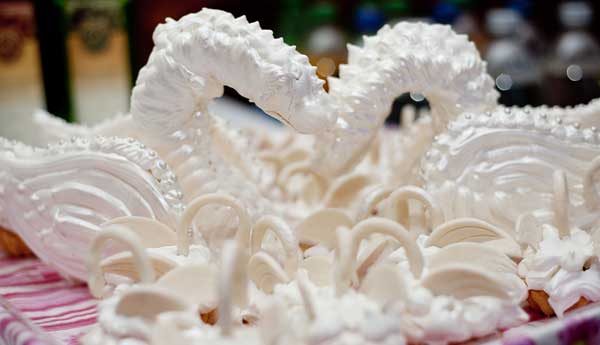Blog
Wedding Traditions: Good & Bad Luck

Wedding Traditions for Your Special Day
Ever wonder if luck has anything to do with your wedding day… or marriage? As a wedding officiant, a personal counsellor to so many married couples and a personal friend to so many ‘happy married couples’ I’ve come to conclusion, “LUCK” has nothing to do with a winning, successful and happy marriage. LUCK may have something to do with winning the lottery…but no too much with a great marriage. In fact I would suggest, WORK, Preservative, and commitment are far more the ingredients of a healthy marriage than any luck will ever bring you. That said, it’s OK to have a little fun and look back on traditions especially as it relates to your wedding day…
Here are 50 “Good & Bad Luck’ omens to add (or Not) to your wedding day:
Good Luck and Bad Luck
- Hey, brides, tuck a sugar cube into your glove — according to Greek culture, the sugar will sweeten your union.
- The English believe a spider found in a wedding dress means good luck. Yikes!
- In English tradition, Wednesday is considered the “best day” to marry, although Monday is for wealth and Tuesday is for health.
- The groom carries the bride across the threshold to bravely protect her from evil spirits lurking below.
- Saturday is the unluckiest wedding day, according to English folklore. Funny — it’s the most popular day of the week to marry!
- Ancient Romans studied pig entrails to determine the luckiest time to marry.
- Rain on your wedding day is actually considered good luck, according to Hindu tradition!
- For good luck, Egyptian women pinch the bride on her wedding day. Ouch!
- Middle Eastern brides paint henna on their hands and feet to protect themselves from the evil eye.
- Peas are thrown at Czech newlyweds instead of rice.
- A Swedish bride puts a silver coin from her father and a gold coin from her mother in each shoe to ensure that she’ll never do without.
- A Finnish bride traditionally went door-to-door collecting gifts in a pillowcase, accompanied by an older married man who represented long marriage.
- Moroccan women take a milk bath to purify themselves before their wedding ceremony.
- In Holland, a pine tree is planted outside the newlyweds’ home as a symbol of fertility and luck.
It’s Got a Ring To It
- Engagement and wedding rings are worn on the fourth finger of the left hand because it was once thought that a vein in that finger led directly to the heart.
- About 70 percent of all brides sport the traditional diamond on the fourth finger of their left hand.
- Priscilla Presley’s engagement ring was a whopping three and a half-carat rock surrounded by a detachable row of smaller diamonds.
- Diamonds set in gold or silver became popular as betrothal rings among wealthy Venetians toward the end of the fifteenth century.
- In the symbolic language of jewels, a sapphire in a wedding ring means marital happiness.
- A pearl engagement ring is said to be bad luck because its shape echoes that of a tear.
- One of history’s earliest engagement rings was given to Princess Mary, daughter of Henry VIII. She was two years old at the time.
- Seventeen tons of gold are made into wedding rings each year in the United States!
- Snake rings dotted with ruby eyes were popular wedding bands in Victorian England — the coils winding into a circle symbolized eternity.
- Aquamarine represents marital harmony and is said to ensure a long, happy marriage.
Fashionable Lore
- Queen Victoria started the Western world’s white wedding dress trend in 1840 — before then, brides simply wore their best dress.
- In Asia, wearing robes with embroidered cranes symbolizes fidelity for the length of a marriage.
- Ancient Greeks and Romans thought the veil protected the bride from evil spirits. Brides have worn veils ever since.
- On her wedding day, Grace Kelly wore a dress with a bodice made from beautiful 125-year-old lace.
- Of course, Jackie Kennedy’s bridesmaids were far from frumpy. She chose pink silk faille and red satin gowns created by African-American designer Ann Lowe (also the creator of Jackie’s dress).
- In Japan, white was always the color of choice for bridal ensembles — long before Queen Victoria popularized it in the Western world.
- Most expensive wedding ever? The marriage of Sheik Rashid Bin Saeed Al Maktoum’s son to Princess Salama in Dubai in May 1981. The price tag? $44 million.
- In Korea, brides don bright hues of red and yellow to take their vows.
- Brides carry or wear “something old” on their wedding day to symbolize continuity with the past.
- In Denmark, brides and grooms traditionally cross-dressed to confuse evil spirits!
- The “something blue” in a bridal ensemble symbolizes purity, fidelity, and love.
Food and Family
- In Egypt, the bride’s family traditionally does all the cooking for a week after the wedding, so the couple can…relax.
- In South Africa, the parents of both bride and groom traditionally carried fire from their hearths to light a new fire in the newlyweds’ hearth.
- The tradition of a wedding cake comes from ancient Rome, where revelers broke a loaf of bread over a bride’s head for fertility’s sake.
- The custom of tiered cakes emerged from a game where the bride and groom attempted to kiss over an ever-higher cake without knocking it over.
- Queen Victoria’s wedding cake weighed a whopping 300 pounds.
- Legend says single women will dream of their future husbands if they sleep with a slice of groom’s cake under their pillows.
- An old wives’ tale: If the younger of two sisters marries first, the older sister must dance barefoot at the wedding or risk never landing a husband.
Show Off at a Cocktail Party
- In many cultures around the world — including Celtic, Hindu and Egyptian weddings — the hands of a bride and groom are literally tied together to demonstrate the couple’s commitment to each other and their new bond as a married couple (giving us the popular phrase “tying the knot”).
- The Roman goddess Juno rules over marriage, the hearth, and childbirth, hence the popularity of June weddings.
- Princess Victoria established the tradition of playing Wagner’s “Bridal Chorus” during her wedding processional in 1858.
- The bride stands to the groom’s left during a Christian ceremony, because in bygone days the groom needed his right hand free to fight off other suitors.
- On average, 7,000 couples marry each day in the United States.
- Valentine’s Day and New Year’s Eve are the two busiest “marriage” days in Las Vegas — elopement central!
- The Catholic tradition of “posting the banns” to announce a marriage originated as a way to ensure the bride and groom were not related.
- Stag parties were first held by ancient Spartan soldiers, who kissed their bachelor days goodbye with a raucous party.
- Home
- Celebrating Your Reception
- Creating Your Perfect Wedding Ceremony
- Destination Weddings & Honeymoons
- Giving Back
- Happy & Healthy Marriages
- Misc Stuff & Fun for the Big Day
- Planning Ahead
- The Legal Stuff
- Themed Weddings
- Wedding Etiquette
- Wedding Shows
- Wedding Trends
- Wedding Vendors That Serve You
- Wedding Venues





